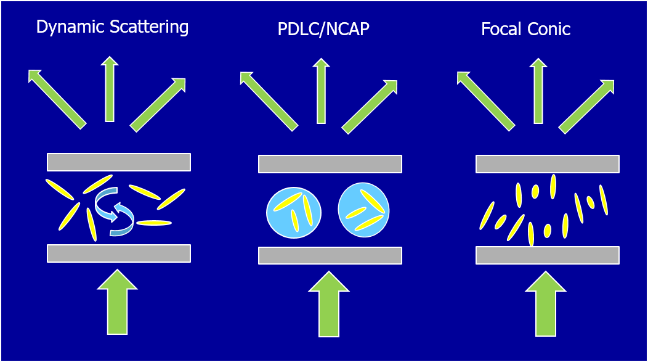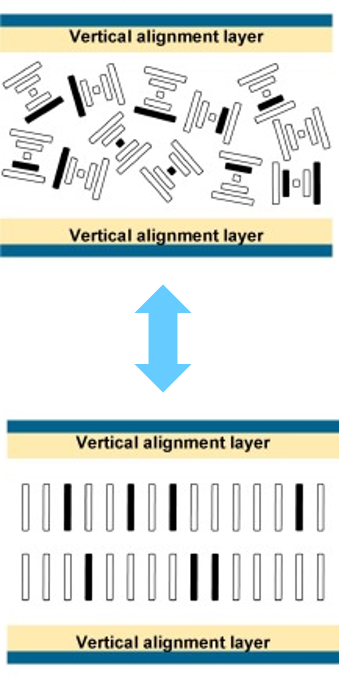
Liquid Crystals
Unlocking the ultimate solution to light-reactive properties
Liquid crystal-based devices were commercialized only 50 years ago, yet in that short span, they have become the main enablers for many game-changing applications by providing unique electro-optic properties that can be controlled.
Over the past 20 years, AlphaMicron’s work has propelled it to become the recognized world leader in many liquid crystals systems. We have invented and commercialisted e-Tint® technology, the first and fastest-changing Electronic Tint-On-Demand™ in the world. (Learn more about e-Tint® here.) Initially put forth as a solution for pilots faced with fast changing lighting conditions, we have now expanded our expertise to multiple industries including sports eyewear, military and tactical, architectural, automotive, AR/VR/MR, and Light Shutters to mention a few.
Liquid Crystal Systems – The Science Of What We Do
AlphaMicron has active programs and materials for each of the systems below:
In light absorptive e-Tint® systems, a dichroic guest dye is added to the liquid crystal host. The dichroism of the dye results in an absorbance that is orientation dependent. These dyes are specifically designed and fabricated to have a tight alignment with the liquid crystal host. Therefore, reorientation of the host by an applied field results in a reorientation of the dye and a subsequent change in the absorbance of the system. In effect, the system behaves as a molecular version of a blind. Non-polarizer based systems have advantages over conventional polarizer-based systems in that they offer the opportunity to shift the transmission window as needed. For example, for eyewear applications, the mixture can achieve clear state transmissions of > 70% which is not achievable by polarizer-based systems.

The inherent birefringence of liquid crystals means that the index of refraction seen by an incident light depends on the relative angle between the polarization of the light and the long axis of the liquid crystal molecules. This property allows the liquid crystal film to be used as a polarization rotator. Since we can alter molecular orientation with an applied field, we can control the degree of polarization rotation. In this way, we can alter light transmission between a pair of crossed polarizers. This type of device provides exceptional light blocking and fast response time. AlphaMicron has demonstrated the first polarizer based devices on curved flexible plastic substrates for intense light protection.

Liquid Crystals can be made to reflect light. In these systems, known as cholesteric or chiral nematic, the liquid crystal has an inherent twist (pitch). When the wavelength of the incident light in the medium matches the pitch of the liquid crystal, the light undergoes reflection. The reflected light has a handedness that matches that of the liquid crystal. These systems can be used as reflective polarizers and are of interest in selective notch filter applications.
AlphaMicron has an active program with the Department of Defense (DoD) on development of these materials for various light protection applications.

Light scattering occurs when there are domains with different average refractive indices. This can be made to occur in liquid crystal systems. The most common methods are Polymer Dispersed Liquid Crystals (PDLCs), cholesteric focal conic texture and field induced dynamic scattering. Each system has its own unique advantages and each can be exploited for a particular application. These systems are typically used for light shuttering applications such as privacy windows but can be adapted to others such as eye training and amblyopia.

It is, at times, highly desirable to have a system that can exhibit multiple optical responses within the same liquid crystal material. For example, a reflective device may need to switch between transparent, absorptive and reflective states. We have addressed these challenges with a patented series of tri-state solutions that further allow for mode performance tailored to the specific application.
These systems can bridge the divide between the tinting devices, where optical clarity is desired, and privacy devices where total occlusion is needed, such as architectural windows and AR/VR/MR applications.

AlphaMicron scientists, working in conjunction with Air Force researchers, have discovered and introduced a new class of liquid crystal material, now known as “Phototropic Liquid Crystals“. Typically, photoresponsive liquid crystalline materials experience a decrease in their order parameter and hence lower ordered states when exposed to activating light. However, this newly phototropic class of liquid crystals discovered by AlphaMicron and colleagues undergoes a surprising increase in order with light exposure. In other words, the material can be forced to undergo a phase transition from isotropic (disordered) to nematic (ordered) phase with light exposures. This capability has been long-sought in ophthalmic and other applications.
This newly discovered material property was first reported in the prestigious journal NATURE: Light-induced liquid crystallinity, 17 May, 2012; Vol. 4 8 5, p. 347.
